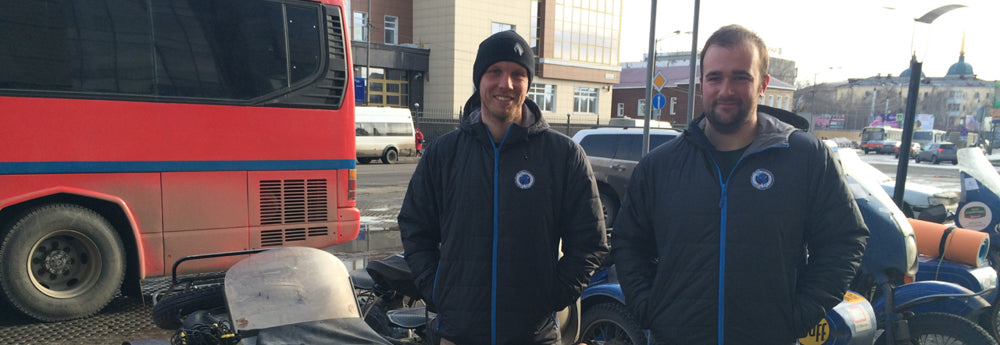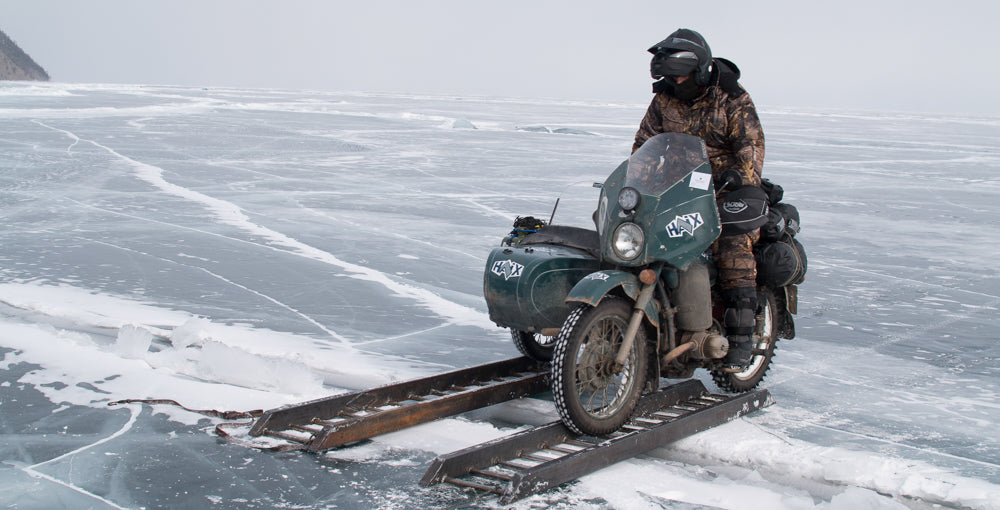
James, can you tell us a little about Marc and yourself?
We are both Paramedics in the Hazardous Area Response Team, Special Operations, South Western Ambulance Service. We work in the same team so we knew we could work together in challenging situations.
How did you get involved with the Ice Run?
I have worked as a Paramedic on one of The Adventurists other challenges, the Mongol Derby. I was showing Marc some details about the Derby online and he saw a photo of the Ice Run. “Thats a Ural!” he said. He told me he had always wanted to go to Russia and ride a Ural, a week later we signed up.
How much did you raise and why the Wiltshire Air Ambulance?
We raised over £1200 for the Air Ambulance mainly from small donations from family and friends. We work alongside our Colleagues at Wiltshire Air Ambulance on a regular basis, last year the Air Ambulance partnership with the Police came to end and with it the amount of money required to keep the service flying rapidly increased. The Air Ambulance is a vital life saving resource for the rural county of Wiltshire and we see first hand the difference it can make.

What is the Ice Run and when is it?
In March this year Marc and I travelled to Irkutsk, Siberia to take part in the Ice Run 2016. Along with a handful of other 2 man teams we navigated the 400 mile length of the frozen Lake Baikal on 30 year old Ural Motorcycles before leaving the lake and winding our way through endless snow covered tracks and roads back to where we started. The Ural is a motorcycle and side care outfit that was reversed engineered by the Russians as a copy of the BMW equivalent in the 1940s. The design, build quality and parts have remained largely unchanged and although very difficult to completely destroy, they are notoriously unreliable!!
Do you have to carry everything?
Yes, as we spent about 12 days on the bikes, we had to be self sufficient in terms of the kit, food and clothing we carried which meant thinking carefully about what we took. Any extra weight strapped to the luggage rack caused extra drag on the un-driven side car which made steering on ice and snow more difficult and getting stuck more likely!
Can you tell us a little more about Lake Baikal?
The lake is huge!, it is the largest lake in the world by volume and at times it felt like we were riding over a frozen sea.
What was the ice like?
The condition of the ice varies hugely across the lake, in some places it is glass smooth very thick with little snow covering, in other places massive shards of ice cover the surface and the small tell tale signs of wide crack in the ice with then edges are very difficult to see. The ice moves a bit like tectonic plates, huge amounts of tension can built in the ice as it freezes at different rates. At night you are often woken by the booming sound of cracks forming-a little bit disconcerting in the pitch black of night when you are wrapped up in a sleeping bag inside a tent!

Did you have any accidents, or close calls?
We had a couple of close calls ourselves, in fact anytime spent on the road is quite risky, the bikes tend to veer when you change gear or apply a little too much throttle, snow and Ice make stopping a little difficult.
Others were not so lucky. Late one afternoon we could see a bike in the distance waving us down, as we got closer we realised the problem. Another team at hit a large crack in the ice, they saw it too late to stop and slid into it side ways. It completely destroyed their sidecar wheel and flipped them over but luckily they were unhurt. They were fortunate enough they had enough speed to carry them across the crack and it wasn’t big enough to loose the bike down to the bottom, or worse with them still onboard. All of us stopped to help them but the delay meant we wouldn’t get to shore before it got dark. Riding at night is a really bad idea for obvious reasons so we stopped to set up camp. We were right in the centre of the lake at its deepest point there is nothing here to slow the wind, and nowhere to shelter. We made a semi circe of Urals, tightly parked end to end and started to pitch our tents, The guy lines have to be screwed into the ice. This was one of the coldest nights, -25c with the wind chill making it feel even colder. It was probably at this point I started to truly appreciate the performance of the armadillo merino base layers we were wearing. Up until this point I hadn’t really given them much thought, they had kept us warm, dry and comfortable so I didn’t really notice them!

What were you wearing?
We spent the entire adventure wearing the long johns and long sleeved top, socks and long neck tube, day and night, they didn’t come off! The Kojak beanie was perfect for the nights in the sleeping bag, excellent warmth without the bulk.
Any particular favourite items?
James: Socks, I didn’t once get cold feet or toes. They were the perfect combination with my chosen boot.
Marc: The beanie. Marc is a little short in the hair department so this was perfect for him, especially during the bitterly cold nights
Armadillo Merino will definitely be top of my kit list for any adventure or trip in the future. It performed excellently, did exactly what we needed it to do and after almost 2 weeks of constant wear it didn’t even smell!

What is next, as the Ice Run will be hard to top?
This summer I am planning to head out to Mongolia for a 12 day over land trip across the Mongolian steppe. I will be camping and although warm, even hot during the day, the temperature can fall significantly at night so i’ll be counting on the merino wool once again.
A little background information.
Notes:
The Ice Run is organised by The Adventurist: www.theadventurists.com
This year was the first official Baikal Ice Run, in 2015 it was tested by a group of ‘pioneers’
Lake Baikal is the largest lake in the world by volume, 400 miles long and a mile deep
We raised money for the Wiltshire Air Ambulance
Temperatures varied between -15c during the day and -25c at night

